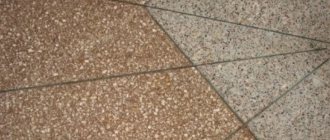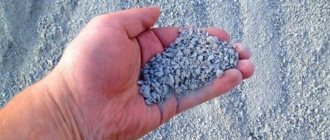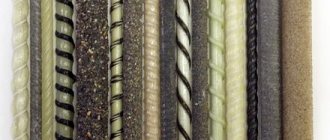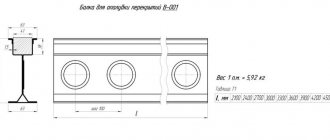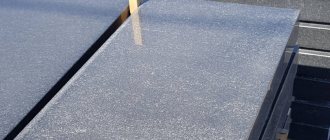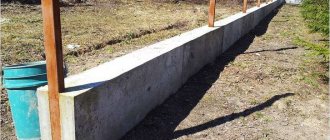Strength and Durability
These properties of a natural rock monument are of paramount importance, especially in Russian climatic conditions. According to these indicators, granite is the absolute favorite: it remains in its original form for more than 500 years. Marble can be preserved without visible damage for 100-150 years. We must not forget that the service life largely depends on the structure of the stone sheet: fine-grained rocks are able to withstand the destructive effects of the environment longer than coarse-grained rocks. Both marble and granite are not afraid of temperature changes, high humidity and frost. However, the moisture absorption of granite is much lower, which makes it invulnerable to acids, fats and mold.
MARBLE CRUSHED STONE IS USED AS:
- filler in tile production;
- filler for concrete floors;
- when installing mosaic floors;
- raw materials for the production of microcalcite (fine ground marble);
- weighting material for drilling fluids;
- a decorative element when designing flower beds (in landscape design).
PRICES FOR DELIVERY OF MARBLE CRUSHED STONE
dated June 01, 2020, including transportation costs in Irkutsk.
Payment by cash and bank transfer is possible.
| 9 200 | 16 400 | 18 900 | 24 800 | 27 800 | 30 800 | ||
| Marble crushed stone (fr. 5 - 10 mm.) | 9 700 | 10 600 | 19 000 | 23 300 | 31 500 | 36 600 | 41 800 |
| Marble crushed stone (fr. 10 - 20 mm.) | 9 800 | 10 700 | 19 600 | 24 300 | 32 800 | 38 400 | 44 000 |
| Marble crushed stone (fr. 20 - 70 mm.) | 8 800 | 9 200 | 16 300 | 18 800 | 24 600 | 27 500 | 30 400 |
Price
Ordering granite will cost the client a little less than marble. However, in any case, the final price largely depends on the complexity of production and design features of the product.
So which natural stone should you choose? If you want to decorate the grave of a loved one with a noble, strict memorial that does not require careful and regular maintenance, feel free to choose granite. To create a complex ritual composition with spectacular bas-reliefs, it is better to use marble. In addition, modern technologies make it possible to combine stones: a granite slab, complemented by an elegant marble sculpture, and other interesting combinations will combine the best qualities of natural rocks.
Other articles
- physical characteristics
- Decorative properties
- Visual cues
When choosing a natural finishing material, we want to know what advantages and disadvantages it has. This article will tell you how granite differs from marble, how to choose them correctly, and why granite finishing is better in some cases, and marble in others.
If you don’t have experience yet, don’t be upset: knowing just a few differences, you can easily determine what material is being offered to you and can avoid common mistakes.
Examples of paving tiles with granite chips
Tiles with granite chips were used for paving.
Tiles with granite chips were used for paving.
Small fractions of granite can have different natural colors (without paint or staining), they shimmer under the rays of light and look extremely impressive. It is thanks to the natural appearance of natural granite chips, beauty and durability that this type of paving slab is so highly valued and is often used to create unique landscape compositions.
What is the difference between granite and marble: physical characteristics
Perhaps, remembering the lessons of history and geography, you will remember that granite is the hardest rock on Earth, and ancient architectural monuments still preserve memories of the skill of once-living craftsmen.
In composition, it is a granular material consisting of crystals of several rocks: potassium feldspar, widespread quartz, plagioclase and mica inclusions of various origins: muscovite and biotite. The density of the rock is 2.6 tons per m3. It is not surprising that the ancient monuments have reached us in their original form, only slightly covered with dust!
If we talk about marble, Greek statues made of snow-white material immediately come to mind. It is softer than granite mass and easier to process. However, being a more fragile material, marble lasts much less, maintaining its original appearance for about 150 years.
It consists mainly of calcium carbonate, compressed under high pressure and exposure to temperatures with admixtures of various minerals. It is foreign inclusions that increase the decorative value of the material, painting it in different colors and forming characteristic patterns. The density of marble is slightly lower than that of granite, and is 2.3 tons per m3.
Speaking of the difference between granite and marble, it is first of all worth noting that granite is much stronger and harder than marble. However, there are still some differences that have decorative significance.
Characteristics of marble chips
According to the main physical, mechanical and operational parameters, bulk building material is included in the category of medium strength. The cost of marble chips is much more profitable than various analogues.
When choosing, you should pay attention to the following main parameters and characteristics of marble chips. For ease of viewing, the data is presented in the table:
| Item No. | Characteristics | Unit | Parameter |
| 1 | Specific gravity | kg/m³ | 2300 — 2900 |
| 2 | Material Density | kg/m³ | 1400 — 1600 |
| 3 | Compressive strength (material dry) | MPa | 50 — 150 |
| 4 | Compressive strength (material – water-saturated) | MPa | 30 — 114 |
| 5 | Water Absorption Percentage | % | no more than 2 |
| 6 | Porosity | % | 0,3 – 1,8 |
| 7 | Radiation activity level | microroentgen/hour | up to 6.0 |
| 8 | Wear level | g/cm² | 1,3 |
These products are divided according to color and decorative properties. The main colors and shades are in the widest possible range, there is a large selection of multi-colored specimens of the breed, a huge variety of shades. Such diversity opens up good opportunities for choosing and making various design decisions when decorating the interior, carrying out landscaping work, etc.
You can order marble chips wholesale in Perm on our website.
The difference between granite and marble: decorative properties
For the most part they have dark, rich shades with multi-colored uniform granular inclusions of various minerals. Rare colors - light gray, almost white or pure black, green, pink. The granite massif is quite easy to cut with clean lines and even, perfect angles, but it is difficult to process where voluminous reliefs are required.
Marble has an exquisite depth of color, most often it is white, milky tones with smoky patterns of other shades, but there are also green, blue, pink, coral, gray and even black varieties of the material. After polishing, the stone acquires a special mirror shine. It is widely used in palace-style floor decoration, forming exquisite rosettes and ornaments.
Speaking about how granite differs from marble, we can say: granite products are more austere, monumental, while marble products are artistic, soft, and delicate. Let's sum it up...
What is the difference between granite and marble: visual signs and physical properties
- Granite is harder and more durable than marble.
- The grainy pattern of granite material differs sharply from the uniform texture and wavy veined pattern of marble, reminiscent of frozen smoke.
- Marble is easier to polish, casting mirror reflections. Granite is not so expressive when polished.
- Granite is easy to heat treat and chemically improve with special compounds; marble is very sensitive to such influences.
Now, knowing the difference between granite and marble, you can easily decide which is best for your property and can create a unique decor to suit your taste.
During the process of building and finishing a house, problems often arise with the choice of materials. If a house is being built to last, there is no better material for exterior and interior decoration than granite marble. However, each of these stones has its own advantages and disadvantages, after studying which you can draw the right conclusions.
Granite
This is a rock of volcanic origin containing quartz (15-35%), which determines its high strength characteristics. Granite practically does not collapse under the influence of precipitation and temperature changes. The undeniable advantages of this material include water resistance (coefficient - 0.5-0.17%) and, accordingly, frost resistance. This material is used for cladding embankments, finishing walls, stairs, fountains, columns, bar counters and table tops. Granite is environmentally friendly. Most types of granite have a natural radiation background corresponding to class I building materials. There are types of material that exceed the norm by 2-3%; they are used in exterior decoration.
Granite is known for its richness of textures. In modern interiors and exteriors of buildings you can find rough and unpolished granite, which absorbs light, as well as polished to a mirror finish, striking with the unique play of sunlight.
The decorative properties of stone can satisfy the requirements of the most intricate design project.
The color palette of the stone is no less rich. The most popular type is considered to be gray granite, but there are also options such as red, pink, green, bluish-gray, orange, black, bluish-green, etc. When deciding whether marble or granite is better, pay attention to the fact that the first is inherent warmer tones, while the second is known for cool tones. Natural stone goes well with metal, wood, and other materials used in decoration.
Marble
This is a sedimentary rock, limestone, which has a certain level of crystallization. The higher the degree of crystallization, the stronger the marble. This material is characterized by an ideal plane even over a large area, which allows it to be used in large-scale works. You won't find a better stone for cladding steps and window sills. Marble has high mechanical strength, exceeding that of concrete by 2-2.5 times. The thread-like structure of the material explains its ability to withstand high dynamic and static loads. In addition, it is resistant to abrasion. Marble floors have not lost their aesthetic properties for decades.
Marble, unlike granite, is easier to process. In addition, products made from this natural stone can be restored. Any scratch can be removed, returning the material to its original appearance.
Unlike many natural stones, marble does not flake. This material is laid to last for centuries. It perfectly dampens noise and vibrations, which is why it is popular in finishing luxury real estate.
The color of marble does not fade over the years, even under the influence of chemicals. The high hygiene and environmental friendliness of the material makes it the best option for cladding kitchen countertops and bathtubs. Marble is not able to accumulate static electricity and is pleasant to the touch. Interiors using it amaze with their luxury, testifying to the status of the owner of the house and his impeccable taste.
Main uses of marble and granite
- Tabletops
In the production of countertops and bathroom sinks, softer natural stone, which is marble, is most often used. Kitchen countertops made from it are also possible, however, during operation there is a high risk of scratches and stains, which cannot be said about granite products.
To care for them, you will have to use only special products; it is not recommended to use alkaline compounds, as they can destroy the polish of the stone. Granite countertops are not that fancy. Countertops made of natural stone can rightfully be called a functional interior decoration.
- Window sills
Window sills are an integral part of any design. At the same time, marble window sills are characterized by high strength and unsurpassed appearance. This is the best option for bedrooms, living rooms and children's rooms. But if the surface of the window sill is planned to be working, you should give preference to granite. Also, due to the high moisture and frost resistance of granite, street window sills (sills) are made from it.
- Stairs.
Stairs with high traffic (in administrative buildings, airports, train stations, offices) are best lined with granite. In the implementation of private interiors, it is worth giving preference not to the durability of the stone, but to the design solution and choosing marble.
- Wall and floor cladding
Natural stones are used in the design of exclusive interiors. This is explained not only by the variety of their textures and colors, but also by their high strength and long service life. When deciding whether marble or granite is better, you should listen to the opinions of experts. For interior decoration, it is better to choose the first option; for exterior decoration, use materials with high physical and mechanical properties, such as granite.
- Swimming pools.
It is recommended to use slabs (large slabs) when finishing swimming pools. This will minimize the number of seams. Light-colored granite marble is perfect for these purposes. In this case, it is better to finish the walls with polished slabs, and the stairs with stone with a rough surface.
- Fireplaces.
Fireplaces with a marble portal are in greatest demand among connoisseurs of beauty. In this case, the shape, configuration and color of the stone can be any. Experts do not recommend using granite for fireplace lining, because it can lose the beauty of its polished texture under the influence of fire.
In construction, granite and marble are considered the most valuable types of natural stones. They have excellent aesthetic properties, practicality, durability, increased resistance to damage and dirt. But the question often arises about which one is better and how they differ from each other.
General description of marble chips
Classic crushed marble chips are a popular material, in demand in industrial and private construction, that is environmentally friendly and has a fairly attractive appearance. The material is in demand, including due to a number of beneficial advantages. The main ones include:
- Minimum background radiation level.
- Optimal physical and mechanical composition, in which substances formed on the basis of carbon and calcium predominate. At the same time, the percentage of a number of other elements included in the mineral remains minimal.
- A variety of colors and shades (from black to snow-white), formed due to various impurities.
- Excellent dielectric properties.
All products manufactured artificially are divided into 5 main groups (according to size parameters):
- The state of flour. The grain size is minimal and does not exceed 160.0 micrometers.
- Sand grains with fraction sizes of no more than 2 millimeters.
- Chopped crumbs. Its range does not exceed 5.0 mm.
- Large fractions (5.0 – 10.0).
- Crushed stone is more than 2 centimeters in diameter.
External differences
Granite is a rock that is of igneous or metamorphic origin. Characterized by a grainy pattern, it consists of quartz, mica and feldspar. It is most common with a light gray color, but its composition can contain many different impurities, so yellow granite, red, bluish, pink and green are found.
Marble is a natural material formed as a result of metamorphism (recrystallization) of carbon-containing compounds (dolomite, limestone). Its composition does not change during the process. By color there are white, gray, yellow, brown, black, green, pink, blue marble, as well as various combinations of these shades.
Colored versions of the material look most original - the presence of veins in the form of cracks filled with natural cements creates unique patterns on the surface of marble. Its true color and pattern appear after polishing.
General technical differences
The strength of granite is several times greater than marble - it is characterized by increased resistance to abrasion, friction and compression. It is also characterized by high levels of hardness and density. It is processed using diamond, and it is possible to achieve a mirror polishing of its surface.
Other distinctive features of these stones:
- The first signs of destruction on high-quality granite appear only after 500 years of operation.
- The service life of white marble is hundreds of years - the first signs of changes appear after 150 years.
- Granite does not require additional protection from acids and is resistant to mechanical damage.
- Marble has a more uniform structure due to uniform grain size and the absence of large inclusions.
- Granite can withstand over 300 freeze and thaw cycles, making it ideal for outdoor applications.
- Marble is more plastic, so it lends itself better to grinding and polishing. And the increased viscosity with sufficient strength makes it resistant to impacts and allows you to create products of complex shapes.
- Optimal types of granite
- Types of granite monuments
- Conclusion
When deciding whether granite or marble is better for a monument, it is important to understand the characteristics of each type of natural stone. Marble and granite have significant differences not only in appearance, they differ in strength and other physical characteristics. We suggest you figure out in which cases marble is chosen, and in which granite.
It is known that marble sculptures are distinguished by high artistry and excellent quality of processing. Expressive statues and complex bas-reliefs are carved from marble. Granite, on the contrary, is more difficult to process, but looks great when creating monuments and obelisks.
Scope of use of granite crushed stone
The scope of application of such a universal product is so wide that it can cope with any type and volume of work. Due to its high strength, time has no power over objects made using it.
The density of the mass of granular materials, taken into account when creating a concrete mixture, allows you to create solutions that can withstand significant loads.
Processing with granite crushed stone of fraction 2–5 mm.
The granite product is used as a design element for interior finishing work.
The use of a product with a fraction of 2.5-5 mm makes it possible to prevent vehicles from slipping on the roadway during icy conditions.
The highest bulk density was recorded for the cubic product of fraction 5-20 and is 1.4 t/m³. The average density of granite for fraction 20-70 and grain sizes 5-20 is 2.68. The presence of contaminants in the bulk material affects the quality of the prepared solutions, due to the deterioration of the adhesion of crushed stone grains to the leading composition.
To remove contaminants, the product is washed with water. According to GOST 8267-93, crushed granite stone is issued a certificate of passing radiological control for the purpose of its further use in construction.
Return to contents
How to decide which is better: granite or marble for a monument?
If we talk about marble, it is an excellent decorative material, but it has several disadvantages:
When choosing a marble tombstone, you should understand: more careful care will be required to maintain its high decorative and artistic quality. Therefore, when deciding whether granite or marble is better for a monument, remember that you will need to pay additional attention to the marble statue.
The advantages of marble material for making tombstones are:
- Easy to process and sand. Thanks to its comparative softness, the stone “comes to life” in the hands of craftsmen. It makes good marble angels bending over a grave in sadness, conveying the smallest details from the wrinkles of clothing to facial expressions.
- Light shades, white. This property is often used to create expressive combinations with black or red granite.
Considering that marble statues darken over time and “cry” with dark streaks, many still prefer statues, which are quite expressive. At the same time, granite is much easier to care for; it retains its shine, even if you have not had the opportunity to regularly care for the tombstone.
Which granite is better for a monument?
The classic black color of a granite tombstone is chosen most often: it is both the color of grief and the high decorative value of the material. The cold shine of polished surfaces, massive details that cannot be destroyed by time, create a feeling that is not subject to centuries.
Brands of black granite that are used for making monuments:
- Absolute Black is distinguished by its purity of color, without inclusions or structural defects. This is how it got its name.
- Black Galaxy - against a black background, small particles of mica can be seen, shimmering with a golden tint in the light. "Black galaxy" effect.
- Gabbro is completely black, pure, rich color. High strength, frost resistance.
- Tan Brown - has coarse-grained inclusions with a hint of brown. Expressive texture, depth of color.
- Dymovsky is very beautiful thanks to its red-brown granular inclusions that shine in the sun in various shades.
However, pure black looks very strict, monumental. It is often complemented by other brands of stone in red, gray and other shades.
Types of granite for a red monument:
- Imperial Red is an almost even, rich color with rare uniform inclusions of gray minerals.
- Kapustinsky is coarse-grained, with an expressive texture and a beautiful pattern of brown-red color with specks of light gray and black.
- Leznikovsky is a rich burgundy color, set off by small specks of black mineral. Many people, without thinking about which granite is best for a monument, choose this stone, which is special in its beauty.
- Yuzhno-Sultaevsky - red-brown large grains are mixed with smaller gray-black ones in a fascinating pattern.
Red natural stone can be used as an additional stone for making tombstones or act as the main material.
Less commonly used are light gray types of granite for the monument: Pokostovsky, Flower of the Urals, Kambulatovsky, Royal White, Mansurovsky or with a yellow tint: Sunset Gold and Crystal Yellow.
There are conflicting reviews about which granite is best for a monument: after all, in essence, this is a matter of taste. All granites have high strength, are frost and moisture resistant, are excellently polished and allow you to create complex designs, sculptures of angels, apply photographs, etc.
All types of granite for monuments have several advantages:
- High strength, not susceptible to growth by fungus and mold. Thanks to this, they remain unchanged for decades and centuries even without proper care.
- Possibility of mirror polishing and application of matte reliefs and images.
- Can be processed to a sufficient level to create sculptures.
- Easy to maintain (special protective impregnation and final polishing with wax are sufficient).
Therefore, when choosing among all types of granite for a monument, you can focus only on your taste and financial capabilities.
Types and sizes of paving slabs with granite chips
Many companies offer paving slabs with granite chips, but not all of them can provide a wide selection of tiles in different sizes, thicknesses and colors. This type of tile can have a different appearance, since granite fractions can be either quite small or larger, have different colors and are combined in various combinations. And, if you clearly understand what kind of paving slabs you need, then you should be prepared for the fact that not every company will be able to provide you with exactly such tiles.
We strive to offer the widest possible selection of paving slabs with granite chips and do everything possible to ensure that our customers can find the material they need. Among the huge range of tiles offered by our company, you will certainly find one that suits you in size, thickness and appearance. Our company also sets affordable prices for all types of tiles, offers favorable terms of cooperation and a number of additional services.
Why should you choose paving slabs with granite chips?
The main advantage of paving slabs with granite chips is that they look as natural and natural as possible. Such tiles will decorate your patio, garden, park and any other place where you decide to use it.
Types of granite monuments
After you have decided which granite is best for the monument, you need to choose the general stylistic direction of the future tombstone. To make it easier for you to imagine the possible options, we suggest considering the types of granite monuments.
By installation location and purpose:
- Single - installed on one grave.
- Double - quite massive monuments, installed on two graves, usually the graves of spouses.
- Children's - it is allowed to deviate from the strict style, to apply images of toys or in the form of teddy bears, angels, a baby's cradle, etc.
Based on the created form, the following types of granite monuments are distinguished:
- Curly - the outlines are made using carvings that form various shapes.
- Straight - usually these are rectangles elongated in height, often with an oblique or curly cut at the top.
- Horizontal - their width significantly exceeds their height, which is why they get their name.
- Crosses
- Monument-chapel
The most often chosen are, of course, curly ones, but straight and horizontal ones are also quite in demand.
There are also types of granite monuments based on the type of decor:
- With wood (usually birch)
- With an angel - an angel can bend over a tombstone and mourn with his head bowed (done by engraving or partially cutting out a three-dimensional sculpture)
- With heart
- With flowers
- With a swan
- With a mourner
In addition to the listed opportunities to decorate a tombstone, the most spectacular is the creation of a separate mourning sculpture.
Which granite monument to choose and the types to use most often determine our financial capabilities. But even in a budget version, a granite tombstone will look decent, preserving the good memory of a dear departed person. And when choosing a more complex decor in an elite design, you can be sure: a granite monument is the best solution for preserving the long-lasting memory of your loved ones.
A little more about which granite is better for a monument
When choosing a color, you need to think about whose memory the monument is being installed. A man is more suited to austerity, so elegant black would be a good choice.
For a woman or young girl, it is better to order something softer, using contrasts, for example, black-red or white-black. It will turn out more expressive and not so strict.
Children's monuments are the most difficult decision. They are often made from light grades of granite, but red, yellow, and black colors can be used.
We hope that our advice on which granite is best for a monument will help you make the right choice and best perpetuate the memory of a departed loved one.
